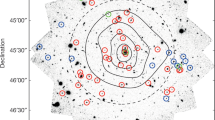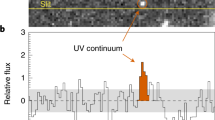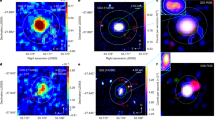Abstract
Optical identification of globular cluster X-ray sources is essential if their evolutionary state and relation to the galactic bulge sources is to be understood. The 10 high-luminosity (⩾1036 erg s−1) X-ray sources associated with globular clusters have very accurate (∼1 arc s) positions from the Einstein Observatory survey1,2. No globular cluster source has yet been optically identified, primarily because all of the bright X-ray sources are located close to the dynamical centre (implying total masses of ∼1.5M⊙ (ref. 2)), where crowding makes optical photometry and spectroscopy extremely difficult. The only northern cluster containing a bright X-ray source is M15, which has the extremely ultraviolet (U − B = −1.2) and variable star AC211 near the X-ray error circle3,4. The reported spectrum is that of an A star5,6, with no emission lines which are normally present in galactic low-mass X-ray binaries. We have now discovered7,8 strong He II 4,686-Å emission from the region of AC211, and weaker Balmer emission. We conclude that it is an intrinsically high-luminosity (Lx⩾1038erg s−1) X-ray source on the basis of the optical brightness of the star and the He II flux. As the observed Lx is only 6 × 1036 erg s−1, this implies that the system is at a high inclination and that only scattered X-rays from an extended region are observed. The mass transfer rate required to account for this is very high and places important constraints on the evolutionary state of the mass-losing star which, for its optical brightness, must either be a red giant or horizontal branch star. The location of AC211 questions the accuracy of the Einstein Observatory positions.
This is a preview of subscription content, access via your institution
Access options
Subscribe to this journal
Receive 51 print issues and online access
$199.00 per year
only $3.90 per issue
Buy this article
- Purchase on Springer Link
- Instant access to full article PDF
Prices may be subject to local taxes which are calculated during checkout
Similar content being viewed by others
References
Hertz, P. & Grindlay, J. E. Astrophys. J. 275, 105–119 (1983).
Grindlay, J. E., Hertz, P., Steiner, J. E., Murray, S. S. & Lightman, A. P. Astrophys. J. 282, L13–L16 (1984).
Aurière, M., Le Fèvre, O. & Terzan, A. Astr. Astrophys. 138, 415–420 (1984).
Aurière, M., Cordoni, J. P. & Koch-Miramond, L. IAU Circ. No. 4101 (1985).
Grindlay, J. E. in Compact Galactic and Extragalactic X-ray Sources (eds Tanaka, Y. & Lewin, W. H. G.) 215 (Proc. Japan-U.S. Seminar, ISAS, Tokyo, 1985).
Grindlay, J. E. in Evolution of Galactic X-ray Binaries (eds Truemper, J., Lewin, W. H. G. & Brinkmann, W.) 25–41 (NATO ASI, Reidel, Dordrecht, 1986).
Charles, P. A., Jones, D. C., Naylor, T. & Boksenberg, A. IAU Circ. No. 4118 (1985).
Charles, P. A., Aurière, M., Ilovaisky, S. & Koch-Miramond, L. IAU Circ. No. 4146 (1985).
Hesser, J. E., Shawl, S. J. & Meyer, J. E. Publ. astr. Soc. Pacif. 98, 403–422 (1986).
Aurière, M., Maucherat, A., Cordoni, J.-P., Fort, B. & Picat, J. P. Astr. Astrophys. 158, 158–160 (1986).
Bradt, H. V. D. & McClintock, J. E. A. Rev. Astr. Astrophys. 21, 13–66 (1983).
van Paradijs, J. in Accretion Driven Stellar X-ray Sources (eds Lewin, W. H. G. & van den Heuvel, E. P. J.) 189–260 (Cambridge University Press, 1983).
White, N. E. & Mason, K. O. Space Sci. Rev. 40, 167–194 (1985).
Savonije, G. J. in Accretion Driven Stellar X-ray Sources (eds Lewin, W. H. G. & van den Heuvel, E. P. J.) 343–366 (Cambridge University Press, 1983).
Renzini, A. in Horizontal-Branch and UV-Bright Stars (ed. Philip, A. G. D.) 19–29 (Davis, New York, 1985).
McClintock, J. E., Canizares, C. R. & Backman, D. E. Astrophys. J. 223, L75–L78 (1978).
Ilovaisky, S. A. & Chevalier, C. IAU Circ. No. 4146 (1985).
Zinn, R. Astrophys. J. 193, 593–605 (1974).
Sweigart, A. V. in Horizontal-Branch and UV-Bright Stars (ed. Philip, A. G. D.) 3–18 (Davis, New York, 1985).
Battistini, P., Bregoli, G., Fusi Pecci, F., Lolli, M. & Epps Bingham, E. A. Astr. Astrophys. Suppl. 61, 487 (1985).
Author information
Authors and Affiliations
Rights and permissions
About this article
Cite this article
Charles, P., Jones, D. & Naylor, T. An emission-line object in the core of M15. Nature 323, 417–419 (1986). https://doi.org/10.1038/323417a0
Received:
Accepted:
Issue Date:
DOI: https://doi.org/10.1038/323417a0
This article is cited by
Comments
By submitting a comment you agree to abide by our Terms and Community Guidelines. If you find something abusive or that does not comply with our terms or guidelines please flag it as inappropriate.



